Recent Posts
Saturday, April 21, 2012
Windows 8 Touchscreen Laptops's Out Look
Posted on 3:25 PM by Admin
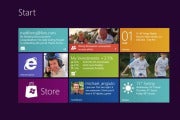 Windows 8’s touch-centric interface will help to usher in a new wave
of laptops with tabletlike touchscreens. To make it easier for users to
tap and swipe on even superthin Ultrabooks, laptop makers will break out
of the traditional clamshell shape and introduce laptops with more
unusual designs.
Windows 8’s touch-centric interface will help to usher in a new wave
of laptops with tabletlike touchscreens. To make it easier for users to
tap and swipe on even superthin Ultrabooks, laptop makers will break out
of the traditional clamshell shape and introduce laptops with more
unusual designs.
What will these new Windows 8 hybrid laptops look like? The new
operating system will make rotating, sliding, and flipping possible on
Windows laptops. Here are a few examples of existing hardware designs
that offer a taste of what a laptop with Windows 8 capabilities could
do.
Going Beyond the Clamshell
Although laptop manufacturers could simply add a touchscreen to a
laptop without changing the traditional clamshell shape, that could pose
a few problems, especially in the case of the new category of superthin
Windows laptops, Ultrabooks.
When trying to interact with the thin touchscreen panel on an
Ultrabook, you could easily end up pushing the screen down. And
according to DigiTimes,
laptop manufacturers can’t just strengthen the hinge to compensate,
because that could cause the bottom of the lightweight laptop to flip up
when you press the screen. Aside from the physics problem, reaching
over the keyboard for extended periods of time with the screen at an
angle might not be ideal for users from a usability or ergonomics
standpoint.
Thankfully, we’ve seen many innovative laptop designs that manufacturers could adopt successfully for Windows 8.
Convertible Tablet Design
Fujitsu Lifebook T580Convertible tablet PCs, such as the Fujitsu Lifebook T580,
have screens that rotate 180 degrees and fold flat to work in tablet
mode. Since their introduction about a decade ago, convertible tablet
PCs have never really taken off outside of niche business and student
circles, owing to their bulky size and high cost.
Windows 8 convertible PCs, however, will likely be not only much
sleeker but also much more budget-friendly than previous tablet
PCs--ditching optical drives and arcane, expensive pen-optimized
displays. Relatively thin Ultrabooks with rotating touchscreens could
take advantage of the finger-friendly Windows Metro interface like a slate, but then could transform back into laptop mode.
Fold-Over Design
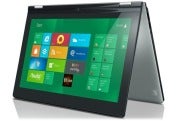 Lenovo IdeaPad Yoga The Lenovo IdeaPad Yoga
presents another possible design solution. This 0.67-inch-thick
Ultrabook, not yet available, flips back 360 degrees on a pair of double
hinges. Propped up on a table like a tent, the Yoga will resist
toppling over when you use touch apps, and it will offer an ideal
viewing and tapping angle. The Yoga can also flip into other positions.
Lenovo IdeaPad Yoga The Lenovo IdeaPad Yoga
presents another possible design solution. This 0.67-inch-thick
Ultrabook, not yet available, flips back 360 degrees on a pair of double
hinges. Propped up on a table like a tent, the Yoga will resist
toppling over when you use touch apps, and it will offer an ideal
viewing and tapping angle. The Yoga can also flip into other positions.
The Yoga’s fold-over design is a newer concept than the
convertible/rotating screen. How the fold-over design actually feels and
works remains to be seen; the Yoga is expected to be released later
this year. Still, it’s an innovative and viable option that other laptop
makers could adopt.
Sliding Screen Design
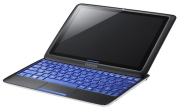 Laptops may also take design inspiration from smartphones, with keyboards that slide out from underneath the touchscreen.
Laptops may also take design inspiration from smartphones, with keyboards that slide out from underneath the touchscreen.
Samsung TX100One example of a model with a sliding screen was the Samsung TX100,
which debuted at CES 2011. This slim tablet PC was reminiscent of the
MacBook Air but had a keyboard that slid out from beneath its screen
just as the original Android G1
smartphone keyboard did. After its introduction at CES, the TX100 was
due to go on sale in spring 2011--in Europe, at least. However, that
never happened.
Another example of a sliding design is the Asus Eee Pad Slider, even
though it’s an Android tablet rather than a laptop. PCWorld’s review of the 10-inch Eee Pad Slider found the design to be effective, with the display sufficiently tilted and sturdy for touch navigation.
Docking Station Design
Perhaps the most versatile option is the docking station design, in
which tablets slide into a docking station (or connect to one
wirelessly) to create a hybrid laptop of sorts.
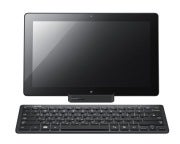 Android tablets--in particular, the Asus Transformer Prime and the more recent Lenovo IdeaTab K2--lead
the way here. While those devices are technically tablets that connect
to docking stations to become more laptoplike, you can find Windows
tablets with laptoplike specs and docking stations.
Android tablets--in particular, the Asus Transformer Prime and the more recent Lenovo IdeaTab K2--lead
the way here. While those devices are technically tablets that connect
to docking stations to become more laptoplike, you can find Windows
tablets with laptoplike specs and docking stations.
Samsung Series 7 tabletFor example, the Samsung Series 7 tablet boasts the same hardware specs as Samsung's Series 7 laptops,
but in a thin and small tablet form. The Windows 7 slate comes with an
Intel Core i3 or i5 processor, a solid-state drive, and 4GB of RAM. The
docking station extends the tablet’s capabilities with a wireless
keyboard and more ports for full laptoplike functionality. A Windows 8 version is in the works.
Windows 8 laptop manufacturers considering incorporating touchscreens
could perhaps go this route, offering the best of both worlds by making
tablets as powerful as laptops with keyboard docking stations. After
all, Microsoft wants Windows 8 to be the “everywhere operating system” for all devices--good on tablets, laptops, smartphones, and everything else, whatever shape or form they come in.
Subscribe to:
Post Comments (Atom)
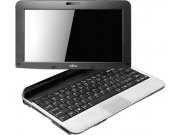
No Response to "Windows 8 Touchscreen Laptops's Out Look"
Leave A Reply